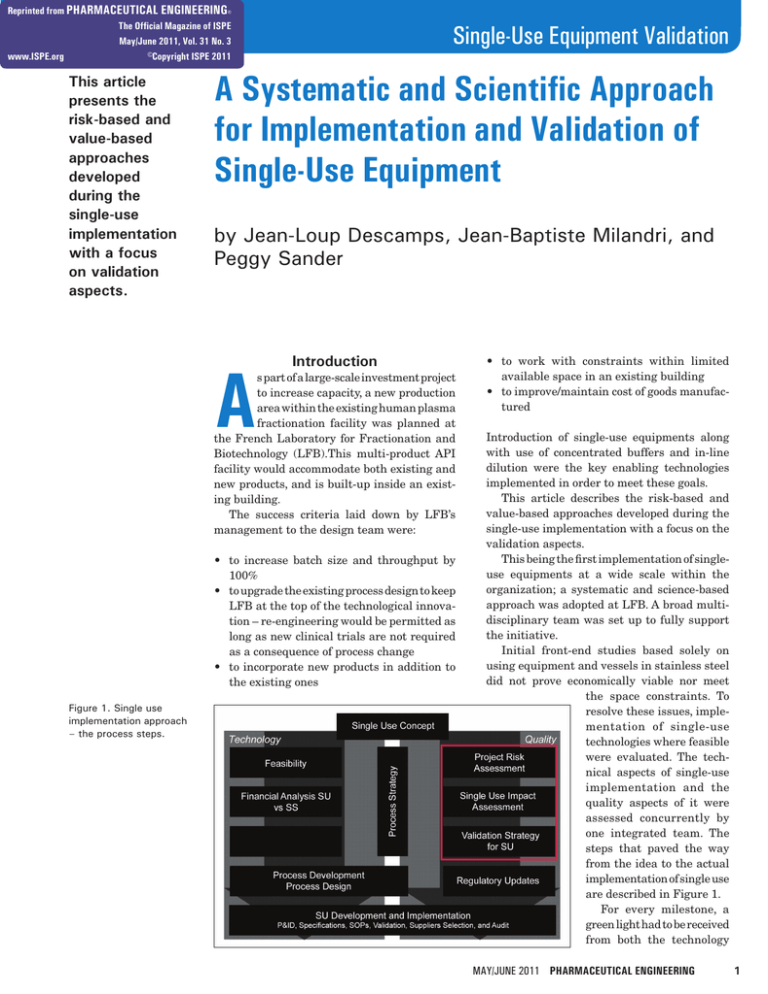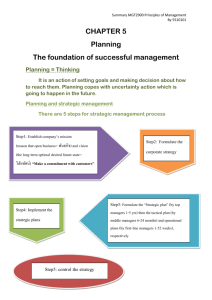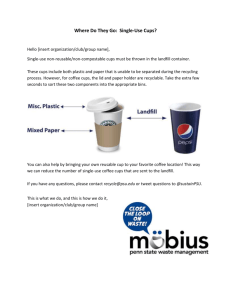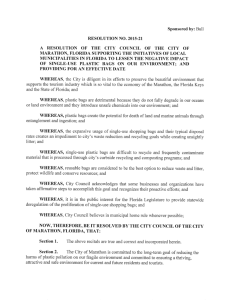Single-use equipment Validation
advertisement

Reprinted from PHARMACEUTICAL ENGINEERING® The Official Magazine of ISPE May/June 2011, Vol. 31 No. 3 www.ISPE.org ©Copyright ISPE 2011 This article presents the risk-based and value-based approaches developed during the single-use implementation with a focus on validation aspects. Single-Use Equipment Validation A Systematic and Scientific Approach for Implementation and Validation of Single-Use Equipment by Jean-Loup Descamps, Jean-Baptiste Milandri, and Peggy Sander A Introduction s part of a large-scale investment project to increase capacity, a new production area within the existing human plasma fractionation facility was planned at the French Laboratory for Fractionation and Biotechnology (LFB).This multi-product API facility would accommodate both existing and new products, and is built-up inside an existing building. The success criteria laid down by LFB’s management to the design team were: • to increase batch size and throughput by 100% • to upgrade the existing process design to keep LFB at the top of the technological innovation – re-engineering would be permitted as long as new clinical trials are not required as a consequence of process change • to incorporate new products in addition to the existing ones Figure 1. Single use implementation approach – the process steps. • to work with constraints within limited available space in an existing building • to improve/maintain cost of goods manufactured Introduction of single-use equipments along with use of concentrated buffers and in-line dilution were the key enabling technologies implemented in order to meet these goals. This article describes the risk-based and value-based approaches developed during the single-use implementation with a focus on the validation aspects. This being the first implementation of singleuse equipments at a wide scale within the organization; a systematic and science-based approach was adopted at LFB. A broad multidisciplinary team was set up to fully support the initiative. Initial front-end studies based solely on using equipment and vessels in stainless steel did not prove economically viable nor meet the space constraints. To resolve these issues, implementation of single-use technologies where feasible were evaluated. The technical aspects of single-use implementation and the quality aspects of it were assessed concurrently by one integrated team. The steps that paved the way from the idea to the actual implementation of single use are described in Figure 1. For every milestone, a green light had to be received from both the technology May/June 2011 PHARMACEUTICAL ENGINEERING 1 Single-Use Equipment Validation • evaluating the extractables and leachables data already available from the single-use bags suppliers • calculating the risk for the product in containing high concentrations of leachables Single-Use Impact Assessment Figure 2. Extent of implementation of single use equipments – a systemic approach. and the quality units of the assessment group. The technical aspects started with a systematic evaluation of replacing the equipment used at each process step by its single-use counterpart. As presented in Figure 2, single-use equipment selection based on technical fit and the quality assurance assessment resulted in a rather limited switchover possible from stainless steel to single-use. Indeed, “only” the storage and the distribution of the buffers used in the various processes run in the new facility could be switched over to single use bags from stainless steel tanks and pipes. However, the change to single-use bags for these purposes did not completely meet the set targets as required. The huge number of bags required generated a dramatic increase in operational costs; therefore, space requirements offset potential benefits. Combining single-use bags for storage with systematic use of concentrated buffers and in-line dilution at the point-of-use significantly improved the business case and was instrumental in meeting the technical project goals. With the technological choices now made, validated, and further evaluated by project risk assessments focusing on quality aspects, the next step was to develop a validation strategy for single–use implementation. As with the technical selection, a systematic, science- and risk-based approach was adopted. Figure 3 describes the different steps of the approach leading to establishing the single-use 2 validation strategy. The goal was to define the appropriate level of testing to be performed based on risks toward the patient, results from validation studies from single-use bag suppliers and extensive know-how historically gained by LFB about its products and processes. On completion of project risk assessments, the focus shifted to single use impact assessments in order to evaluate and mitigate the risk of implementing single-use systems and concentrated buffers in manufacturing processes for the products already on the market. This assessment led to identifying three risk mitigations: • defining and performing stability studies Single-use technology implementation brings about important changes in the process handling and also impacts different aspects of the product chain such as Purchasing, Quality Control, Operational Quality Assurance and Validation, Production, Process, and Regulatory Affairs - Figure 4. Impact analysis on these different functions was performed in order to identify criticality, associated risks, and actions to be taken in order to mitigate them. Process evaluation was assessed as the most important part of the “scope.” For this reason and in order to secure and identify all potential risks, a global evaluation of single-use technology was performed focusing on the impact on the final product. The goal of this assessment was to evaluate and mitigate the risk of implementing single-use systems and concentrated buffers in the manufacturing processes. The Failure Mode and Effects Analysis (FMEA) method was applied across different departments (Suppliers Quality Assurance, Production Quality Figure 3. Global single use validation strategy – evaluation steps. PHARMACEUTICAL ENGINEERING May/June 2011 Single-Use Equipment Validation Figure 4. Single-use implementation – global evaluation and functional interactions. Assurance, Product Validation, Production, Process) in several steps: • Identification and evaluation of risks directly or indirectly linked to the implementation of single-use for each step of the bag’s lifecycle (material receipt, production, quality control, disposal) and of the manufacturing process (from the buffer preparation in tanks to the in-line dilution equipment going through storage, transport, and connection to equipment outlet with multipletapping). • Assessment of each risk were evaluated on: - Severity: assessing risks from “no impact” to quality, security or product efficiency and ultimately the risk to patient. - Detection: assessing risks from “absence of detection” to possibility/existence of automated detection of process non-conformity. - Occurrence: assessing risks from “no occurrence” to registration of the default process risk at each use. This single-use impact assessment has shown that the main risks were: • Product contamination by leachables due to: - Switchover from stainless steel to single-use – potentially inducing different quantities or new leachables in the final product. - Use of concentrated buffers in single-use bags potentially generating leachables or changing product behaviour as a result of addition of a process step (buffer storage) and of modifying buffer formulation to a more aggressive composition (10X concentration). • Cross-contamination due to multiuse (bags used multiple times in process rooms and held at storage area in between uses) and the possibility of contamination of bags at each use. An action plan has further been applied to address these main risks in order to mitigate them: • • • • stability studies suppliers agreement/validation product risk assessment preference for single-tapping scenario instead of multiple-tapping Stepwise evaluations allowed the team to conclude that all risks have been reduced to an acceptable level. Stability Studies Some buffer solutions parameters are critical to the processing conditions required during purification steps, and deviations can result in lower yields and adversely impact product quality. Parameters such as pH, conductivity, and temperature can have a huge influence on the protein binding characteristics. Physicochemical parameters can vary during processing steps. To ensure that changes introduced did not affect product quality, stability studies were performed on the buffer solutions used across the entire process (including process buffers for regeneration/cleaning/sanitization buffers). The objective of this study also was to determine the variations of the parameters of the buffer solutions during storage and stability over maximum required storage time. The scope of the study extended to 19 buffer formulations identified within the project scope. Instead of simply studying all the solutions, a sciencebased approach was adopted to reduce the number of tests to be performed. Principal Component Analysis (PCA) method was used to define families of buffer solutions and their model solutions. The stability of the model solutions was tested and the tests results extended to the whole family members. This statistical study took the following into account for each formulation: the composition of the buffers in amino acid, salts, acid, base, and Tris (Trometamol). The components are defined as variables. This statistical procedure performed a principal components analysis. The purpose of the analysis was to obtain a small number of linear combinations of the five variables which account for most of the variability in the data. In this case – as shown in Table A, three components were extracted since three components had eigenvalues greater than or equal to 1.0. Together they accounted for 71.8 % of the variability in the original data and thus provided a Component Number Eigenvalue Percent of Variance Cumulative Percentage 1 1,51674 30,335 30,335 2 1,22487 24,497 54,832 3 1,08779 21,756 76,588 4 0,630658 12,613 89,201 5 0,539941 10,799 100,000 Table A. Statistical procedure showing variance of each component. May/June 2011 PHARMACEUTICAL ENGINEERING 3 Single-Use Equipment Validation the confidence in moving to the next steps of the project. Supplier Validation Evaluation In order to mitigate the risk of introducing new product containers (single-use bags instead of stainless steel tanks), the suppliers of these bags were validated according to the following method: Figure 5. Biplot graph showing contribution of component on the buffer formulation position (software: Statgraphics Centurion XV). representative statistical model of the formulation variability. The multiple linear regression determines each solution position and defines homogeneous family groups. A biplot graph of two of the three components enabled identification of seven homogeneous families of solutions - Figure 5: • amino acids family (e.g., solutions with glycine component) • salts family (e.g., solutions with sodium acetate component) • salts and acids family (e.g., solutions with sodium acetate and acetic acid components) • acid family (e.g., solutions with sodium acetate and acetic acid components) • base family (e.g., solutions with sodium hydroxyde component) • tris family (e.g., solutions with trometamol component) • neutral family (e.g., solutions with sodium phosphate component) This biplot shows selected principal components 1 and 2 (X and Y axis). There is a point on the plot for each row in the tabular data file (solutions: Alfadeae2, Naoh1m…). Lines are also drawn for each of the variables (compositions: acids, salts…), representing their location in the space of the components. A weight close to 0 indicates little contribution of the variable to 4 that component. The statistical study could not define the model solution for each family. This choice had to be done according to industrial considerations as: • frequency of usage • relative concentration of components • criticality of the process step where the solution is used This approach proved very efficient as the number of studies required for improving the process understanding were reduced from 19 to 7. Any nonconformity in the tests of the model solution would have resulted in repeating the stability studies on all the solutions of the family. On completion of the stability studies with the critical physico-chemical parameters and microbial contamination of the model solutions defined – the variability of the parameters were analyzed over extended storage times and under storage conditions representative of real production storage. The studies were performed at a smaller scale, which could be considered as a worst case due to higher critical container-content interaction (higher contact surface to volume ratio). The first results provided a positive conclusion as no non-conformities were identified on the model solutions. This gave the project team the impetus and PHARMACEUTICAL ENGINEERING May/June 2011 • compilation of validation data from each potential supplier • analysis of tests performed by vendors and comparison to suppliers already validated • analysis of standard extractables/ leachables studies done by suppliers against actual buffers used in the manufacturing processes • determination of missing data (gap analysis) Each supplier had made available full validation guides1-8 for the chosen bags, including test procedures, results, and standards used for product-contact container and where available extractables/leachables studies with tested solutions. All suppliers of single-use components perform tests required as standard, such as: • biological compatibility and compendial compliance (USP, EP) • glass transition temperature • permeability The above are in compliance with USP 88, class VI; USP 87 et USP 85, meaning that procedures are similar. It is not always possible to get quantitative results, as sometimes results were expressed as conforms/does not conform or as complying to a range value. However, this evaluation showed that all results presented by suppliers were in compliance with the acceptance criteria. Some differences could be seen, but they were not considered significant. All the single-use suppliers also have data on extractables studies with some typical solutions. Differences between data sets provided by suppliers had to be taken into consideration as conditions and procedures are not equivalent. Size Single-Use Equipment Validation of the containers, storage temperatures, and duration of storage varied, but all suppliers simulated tests in extreme processing conditions. Due to variations in testing methods, a systematic one-to-one comparison of the suppliers was not possible. Comparisons based on the buffers used in the manufacturing processes were preferred, which meant that some of their typical solutions were identical or close to manufacturing process buffers (e.g., same formulation but higher concentration). According to the validation strategy, if the supplier has already done some extractables/leachables studies with solutions fitting with the model solution characteristics, the tests did not have to be repeated during the validation. In addition, some specific tests could further be used as selection criteria between the suppliers as some of them did not perform all tests. This was used in combination with other specific properties and advantages of the different film composition of the bags: • • • • • • • puncture resistance tensile strength resistance transportability limpidity of the film pH stability adsorption connection tests In order to finalize the evaluation, an overview of the missing data needed for the supplier certification was made: identification of infra-red spectrum, film composition detail, certification of the absence of animal-derived compounds, gamma-irradiation validation. This specific evaluation was part of the supplier assessment and was performed in parallel with a more standard approach for supplier selection and accreditation (audit, technical and price evaluation regarding user requirements, assurance of supply, etc.) This global approach proved to be a very strong and rational basis to select two suppliers who would provide all single-use bags required in the facility. Product Risk Assessment The goal of this assessment was to explore the toxicological impact of potential leachables in the final product. The first step was to evaluate the leachables quantities reported by the suppliers in their validation guide. Based on the data made available, the project team evaluated the risk as low. Reported values of leachables were in the ranges of ppm or ppb, and thus the expected level at process conditions was likely to be even lower. Nevertheless, to consolidate the approach, it was decided to establish quantitatively the theoretical amounts of leachables that could be expected in the final product. These calculations evaluated by the toxicology experts concluded that the amounts of leachables found represented “no risk” for the patient. This is why, considering this global strategy, it was decided not to redo tests already done by vendors and instead, use their bibliography. The scope of the study included bags, connectors, filters, manifolds, and tubing elements. Input data were issued from studies done by one of the possible supplier. Input data selected on the test list described by the supplier are described in Table A with the rationale detailing why they were chosen. The whole list of test and typical solutions tested can be found in the vendors validation guide with a precised description of test conditions and Quality Control Method used to detect leachables. The quantification of the leachables were executed according to two scenarios: • Worst case scenario: purification processing steps do not decrease the initial amount of leachables. • Real case: purification process steps contribute to the elimination of the leachables (process steps allowing elimination of leachables have been defined with their elimination rate). Assumptions on input data: • Filters, manifold, connectors, and tubing were already being used in the former process without impact on the product, and hence not considered as contributors and excluded from this quantification. • Bags which are considered as the highest contributors are evaluated for two categories of usage: regeneration/sanitization process steps and purification process steps. Regeneration/sanitization steps were not considered as being able to generate leachables in the product as their objective is to desorb nontarget proteins and other biological contaminants from the equipment without any product contact time. As described in Table B, the quantification of leachables in the final product was made considering the following data and parameters: • identification of process steps using single-use bags, represented in the column “Process steps” • determination of number and type of single-use bags used for each step, shown in the column “Single-use systems” • determination of bag volume considering standard bag size from vendors and introduction of this data in the column “bag size” • determination of bag filling volume regarding process need in the column Input Data Rationale Identified amount of leachables brought by 500 mL bags (ethyl acetate, silyl siloxane, acetone, butanal, ethanol) 500 mL bags as the worst case Data after 30 days storage at 25°C ±2°C Similar storage conditions as routine storage conditions Data on bags filled with: - WFI - HCl (pH 2) and NaOH (pH 11) Representative of salt solutions Representative of regeneration solutions Table B. Synthesis of input data for product risk assessment. May/June 2011 PHARMACEUTICAL ENGINEERING 5 Single-Use Equipment Validation “bag filling volume” (buffer volume required by the process including a safety volume) • use of extractables data made available by suppliers (extractable found in the representative solution from the vendor is precised in the 1st line with its corresponding minimum and maximum value measured by the vendor chosen for this study)1-8 • use of ratio of contact surface by filling volume of bags used during supplier validation For each process step, extrapolation of leachable amounts were calculated for each bag considering proportionality between: • contact surface of the buffer with the bag used during the vendor test conditions of the representative solution • contact surface of the buffer planned to be used in the future process operating conditions Then a summation of this amount was calculated until the final product step provided a final theoretical amount of leachables in the final product, for both a worst case and a more realistic case (represented in each 2nd line of the green part of Table C showing intermediate process step or product storage step). This final amount was reported to the product volume in order to obtain a final concentration of each leachable, as indicated in the last line of Table C. As presented in Table C, the results obtained from this study have shown concentration of some leachables around 500 ppb in the theoretical worst case and of about 1,5 ppb in the real conditions. All the above data were evaluated by toxicology experts with respect to: • theoretical amount of leachables in final product • criticality of leachables for human safety • product dose • dosage • administration route The initial conclusion from the preliminary studies was that the calculated amounts are within the detection limits of the analytical methods and toxicology experts conclude that these amounts are not critical for the product safety. Conclusion The systematic and scientific approach developed in the project gave the project team strong background knowledge to assess risks and consequently minimize additional testing for validation. Table C. Theoretical forecasts of leachables concentrations in the final product – worst case (extract). 6 PHARMACEUTICAL ENGINEERING May/June 2011 Single-Use Equipment Validation The initial results from stability studies are now available and are very encouraging, leading to the conclusion that the methodology chosen demonstrates that it’s possible to create a very strong basis for the validation of the single use systems and Common Technical Document (CTD) dossiers updates, while keeping the extent of tests at a moderate level without compromising the safety of the products, and thereby of the end users. The key is to allocate time and the right resources to the study and to never compromise the systematic and step-by-step execution of the study. With the same systematic and science- and risk-based approach, LFB is now extending the implementation of single use systems to its new and current manufacturing processes. But as a company entering large scale single-use processing, there are several challenges along that road that need to be addressed: • Regulatory requirements and barriers for implementing disposables are being raised higher. • Finding the appropriate validation strategies. • Managing approval and the change control of suppliers increases constraints and related costs. Further developing the science- and risk-based approach presented in this article could contribute to overcoming these challenges. Glossary API Active Pharmaceutical Ingredient EP European Pharmacopeia FMEA Failure Mode and Effects Analysis LFB Laboratoire français du Fractionnement et des Biotechnologies SOP Standard Operating Procedure SU Single-Use SS Stainless Steel USP United States Pharmacopeia References 1. Sartorius Stedim biotech – Flexel® Bags – Extractables Analysis. 2. Validation Guide – Flexel® 2D and 3D bags. 3. Pall Life Sciences – Validation Guide USTR 2475 – AllegroTM 2D Biocontainers. 4. Millipore – Validation Guide – PureFlex™ Film. 5. Millipore – PureflexTM process container film – Specifications sheet. 6. Millipore – PureflexTM and Sureflex™ extractables analysis. 7. Millipore – On chemical compatibility of Millipore’s PureflexTM film. 8. Hyclone – Characterization of Single-Use Bioprocess ContainerTM Systems based on HyQ® CX5-14 Film. Acknowledgements Gilles Beaudoin, LFB Eric Medal, LFB Stéphanie Senechal, NNE Pharmaplan About the Authors Jean-Loup Descamps is an engineer in industrial biochemistry and in agri-foodindustry. He has a master’s degree in quality in the food industry. He started his career in microbiology development at Sanofi Diagnostics Pasteur in 1987. He currently serves as scientific and regulatory support manager for industrial development at the French Laboratory for Fractionation and Biotechnologies (LFB) Biomedicaments, France. He has been involved successively in development, quality control, validation, and technology transfer activities. He can be reached by telephone: +33-3-20-4944-44 or by email: descamps@lfb.fr. LFB, 59, rue de Trévise, B.P. 2006, 59011 Lille Cedex, France. Jean-Baptiste Milandri is biotech process engineer at NNE Pharmaplan in Denmark. After positions in research, vaccine manufacturing, management consulting, Milandri joined NNE Pharmaplan in France acting as process engineer and as project manager, in charge of designing several biotech facilities. He is now part of the consulting group in Denmark, leading and supporting innovative biotech process design and implementation and developing new advanced solutions for the biotech market. Milandri received an MS in cell biology and biochemistry from Paris-XI University, France and an MS in biotech engineering from the Compiegne University of Technology, France. He can be reached by email: jbmi@nnepharmaplan.com. NNE Pharmaplan,Vandtarnsvej 108 – 110, DK-2860 Soborg, Denmark. Peggy Sander is an engineer in the pharmaceutical industry. She has an educational background in bioprocess engineering. She started her career in washing and sterilization equipment in Novo Nordisk in 2005. She is currently working in NNE Pharmaplan as a process engineer responsible for process package from design until commissioning. She mainly works in downstream process or single use implementation. She can be contacted by telephone: +33-2-37-88-79-50 or by email: pggs@nnepharmaplan.com. NNE Pharmaplan, 9, rue Edmond Poillot, 28000 Chartres, France. May/June 2011 PHARMACEUTICAL ENGINEERING 7






